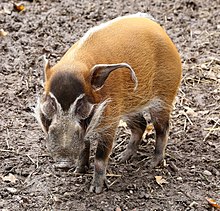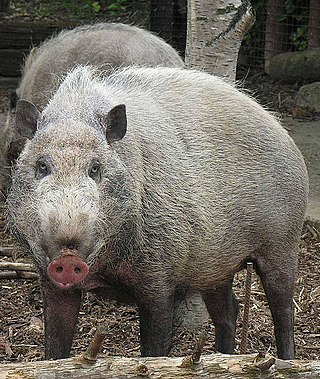
Sus is the genus of wild and domestic pigs, within the even-toed ungulate family Suidae. Sus include domestic pigs and their ancestor, the common Eurasian wild boar, along with other species. Sus species, like all suids, are native to the Eurasian and African continents, ranging from Europe to the Pacific islands. Suids other than the pig are the babirusa of Indonesia, the pygmy hog of South Asia, the warthogs of Africa, and other pig genera from Africa. The suids are a sister clade to peccaries.

The wild boar, also known as the wild swine, common wild pig, Eurasian wild pig, or simply wild pig, is a suid native to much of Eurasia and North Africa, and has been introduced to the Americas and Oceania. The species is now one of the widest-ranging mammals in the world, as well as the most widespread suiform. It has been assessed as least concern on the IUCN Red List due to its wide range, high numbers, and adaptability to a diversity of habitats. It has become an invasive species in part of its introduced range. Wild boars probably originated in Southeast Asia during the Early Pleistocene and outcompeted other suid species as they spread throughout the Old World.

The common warthog is a wild member of the pig family (Suidae) found in grassland, savanna, and woodland in sub-Saharan Africa. In the past, it was commonly treated as a subspecies of P. aethiopicus, but today that scientific name is restricted to the desert warthog of northern Kenya, Somalia, and eastern Ethiopia.

Suidae is a family of artiodactyl mammals which are commonly called pigs, hogs or swine. In addition to numerous fossil species, 18 extant species are currently recognized, classified into between four and eight genera. Within this family, the genus Sus includes the domestic pig, Sus scrofa domesticus or Sus domesticus, and many species of wild pig from Europe to the Pacific. Other genera include babirusas and warthogs. All suids, or swine, are native to the Old World, ranging from Asia to Europe and Africa.
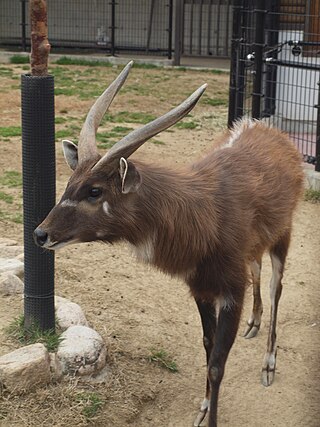
The sitatunga or marshbuck is a swamp-dwelling medium-sized antelope found throughout central Africa, centering on the Democratic Republic of the Congo, the Republic of the Congo, Cameroon, parts of Southern Sudan, Equatorial Guinea, Burundi, Ghana, Botswana, Rwanda, Zambia, Gabon, the Central African Republic, Tanzania, Uganda and Kenya. The sitatunga is mostly confined to swampy and marshy habitats. Here they occur in tall and dense vegetation as well as seasonal swamps, marshy clearings in forests, riparian thickets and mangrove swamps.
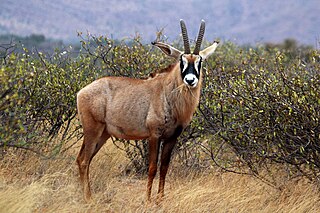
The roan antelope is a large savanna-dwelling antelope found in western, central, and southern Africa. Named for its roan colour, it has lighter underbellies, white eyebrows and cheeks and black faces, lighter in females. It has short, erect manes, very light beards and prominent red nostrils. It is one of the largest antelope, measuring 190–240 cm (75–94 in) from head to the base of the tail, and a 37–48 cm (15–19 in) long tail. Males weigh 242–300 kg (534–661 lb) and females 223–280 kg (492–617 lb). Its shoulder height is around 130–140 cm (51–55 in).
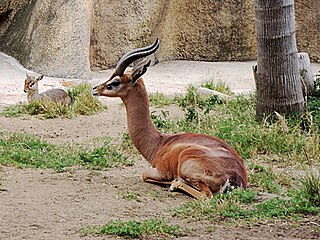
The gerenuk, also known as the giraffe gazelle, is a long-necked, medium-sized antelope found in parts of East Africa. The sole member of the genus Litocranius, the gerenuk was first described by the naturalist Victor Brooke in 1879. It is characterised by its long, slender neck and limbs. The antelope is 80–105 centimetres tall, and weighs between 18 and 52 kilograms. Two types of colouration are clearly visible on the smooth coat: the reddish brown back or the "saddle", and the lighter flanks, fawn to buff. The horns, present only on males, are lyre-shaped. Curving backward then slightly forward, these measure 25–44 cm.

A feral pig is a domestic pig which has gone feral, meaning it lives in the wild. The term feral pig has also been applied to wild boars, which can interbreed with domestic pigs. They are found mostly in the Americas and Australia. Razorback and wild hog are Americanisms applied to feral pigs or boar–pig hybrids.

The bushpig is a member of the pig family that inhabits forests, woodland, riverine vegetation and cultivated areas in East and Southern Africa. Probably introduced populations are also present in Madagascar. There have also been unverified reports of their presence on the Comoro island of Mayotte. Bushpigs are mainly nocturnal. There are several subspecies.

The pygmy hog is a very small and endangered species of pig and the only species in the genus Porcula. Endemic to India, the pygmy hog is a suid native of the alluvial grasslands in the foothills of the Himalayas, at elevations of up to 300 m (980 ft). Populations of pygmy hogs were once widespread in the tall, dense, wet grasslands in a narrow belt of the southern Himalayan foothills from north-western Uttar Pradesh to Assam, through southern Nepal and North Bengal, and possibly extending into contiguous habitats in southern Bhutan. Due to human encroachment and destruction of the pygmy hogs’ natural habitat, the species was thought to have gone extinct in the early 1960s. However, in 1971, a small pygmy hog population was rediscovered as they were fleeing a fire near the Barnadi Wildlife Sanctuary in Assam. Today, the only known population of pygmy hogs resides in Manas National Park in Assam, India. The population is threatened by livestock grazing, fires and poaching. With an estimated population of less than 250 mature individuals, the pygmy hog is listed as an Endangered species on the IUCN Red List, and conservation efforts such as captive breeding and re-release programs are currently being employed.
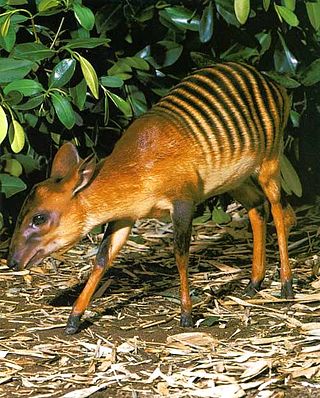
The zebra duiker is a small antelope found primarily in Liberia, as well as the Ivory Coast, Sierra Leone, and occasionally Guinea. They are sometimes referred to as the banded duiker or striped-back duiker. It is believed to be one of the earliest duiker species to have evolved.

The giant forest hog, the only member of its genus (Hylochoerus), is native to wooded habitats in Africa and is one of the largest wild members of the pig family, Suidae, along with a few subspecies of the wild boar. It was first described in 1904. The specific name honours Richard Meinertzhagen, who shot the type specimen in Kenya and had it shipped to the Natural History Museum in England.

The Philippine warty pig is one of four known species in the pig genus (Sus) endemic to the Philippines. They have tufts of hair on the top of their head and on the lower sides of their jaws, as well as four warts on their faces. Their skulls are elongated; males have tusks and bigger skulls than females, an example of sexual dimorphism. They are considered Vulnerable by the IUCN, and their population is currently declining due to multiple threats. The pigs are probably nocturnal.

Kolpochoerus is an extinct genus of the pig family Suidae related to the modern-day genera Hylochoerus, Phacochoerus, and Potamochoerus. It is believed that most of them inhabited African forests, as opposed to the bushpig and red river hog that inhabit open brush and savannas. There are currently eleven recognized species.

The desert warthog is a species of even-toed ungulate in the pig family (Suidae), found in northern Kenya and Somalia, and possibly Djibouti, Eritrea, and Ethiopia. This is the range of the extant subspecies, commonly known as the Somali warthog. Another subspecies, commonly known as the Cape warthog, became extinct around 1865, but formerly occurred in South Africa.

Phacochoerus is a genus in the family Suidae, commonly known as warthogs. They are pigs who live in open and semi-open habitats, even in quite arid regions, in sub-Saharan Africa. The two species were formerly considered conspecific under the scientific name Phacochoerus aethiopicus, but today this is limited to the desert warthog, while the best-known and most widespread species, the common warthog, is Phacochoerus africanus.

The Gabon talapoin, also known as the northern talapoin, is a small species of African monkey native to riparian habitats in Cameroon, Equatorial Guinea, Gabon, the western Republic of the Congo and the far western Democratic Republic of Congo. It may have been introduced to Bioko and the Canary Islands. Classified in the genus Miopithecus, it was given the name Miopithecus ogouensis, based on the River Ogooué, distinguishing it from the other species, the Angolan talapoin, also known as Miopithecus talapoin.

Potamochoerus is a genus in the pig family (Suidae). The two species are restricted to sub-Saharan Africa, although the bushpig, possibly due to introduction by humans, also occurs in Madagascar and nearby islands. Early in the 20th century, there were considered to be as many as five different species within the genus. These were gradually consolidated, until, in the 1970s, it was generally agreed that all were representatives of just a single species. The bushpig was again recognised as a separate species from about 1993.

Boar–pig hybrid is a hybridized offspring of a cross between the Eurasian wild boar and any domestic pig. Feral hybrids exist throughout Eurasia, the Americas, Australia, and in other places where European settlers imported wild boars to use as game animals. In many areas, a variable mixture of these hybrids and feral pigs of all-domesticated original stock have become invasive species. Their status as pest animals has reached crisis proportions in Australia, parts of Brazil, and parts of the United States, and the animals are often freely hunted in hopes of eradicating them or at least reducing them to a controllable population.
